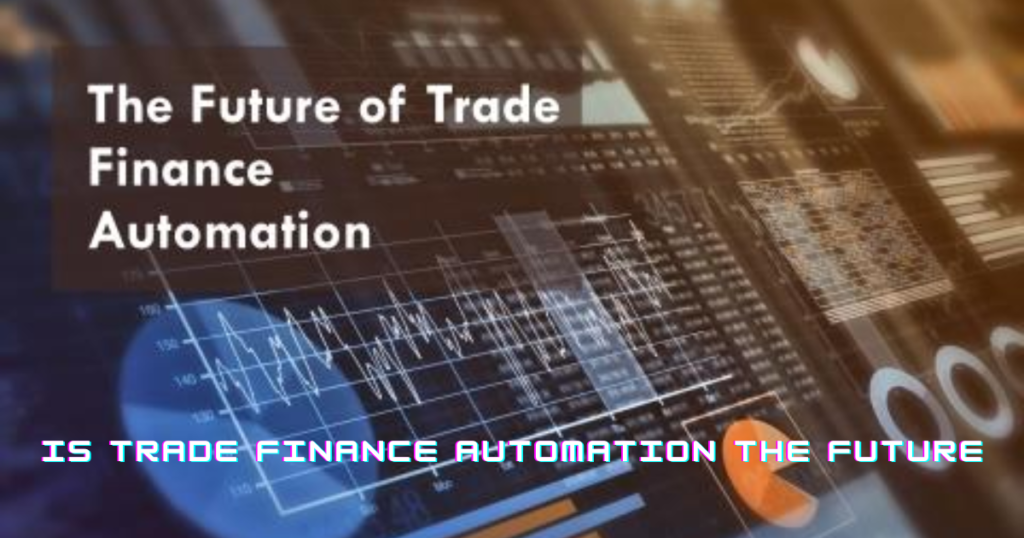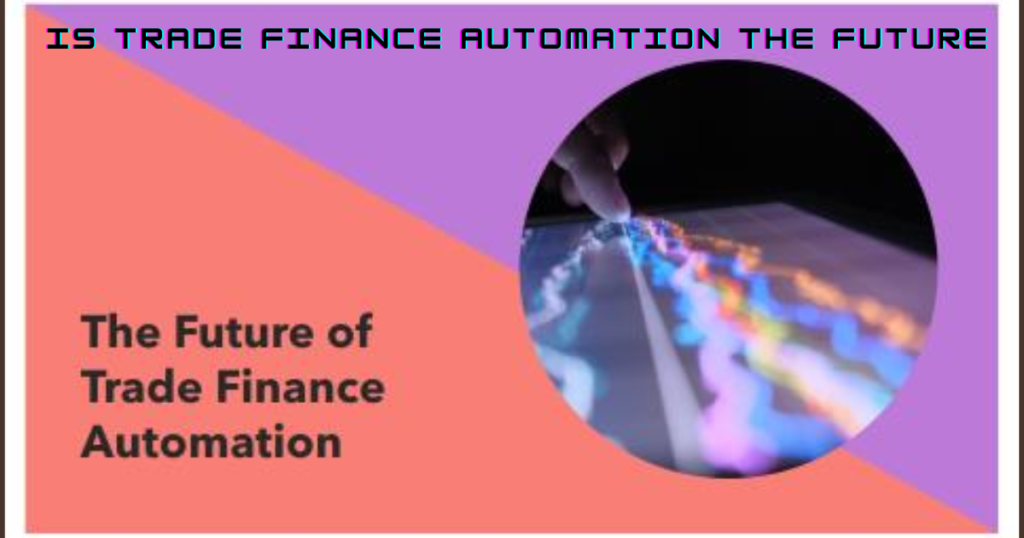Introduction:
Welcome to the dynamic realm of trade finance automation in 2024, where traditional practices are making way for cutting-edge technologies. In this blog post, we will delve into the current state of trade finance, its future prospects, and the advantages and challenges posed by automation. Buckle up as we explore the exciting transformations reshaping the landscape of trade finance.

Trade Finance Automation in 2024: Navigating the Digital Landscape
The Current Landscape
Trade finance, a critical component of corporate banking, has historically relied on manual processes. However, the winds of change are blowing, and the industry is gradually embracing digital transformation. Here’s where we stand today:
- Paper-Based Practices Persist: Despite the push for digitalization, trade finance remains entangled in paper-based practices. Billions of trade documents are exchanged annually, with many still relying on physical paperwork for verification.
- AI-Powered Automation: Enter artificial intelligence (AI). AI-oriented automation can revolutionize trade finance by reading and assessing paper documents. Imagine an AI system that detects anomalies, such as evidence of fraud or sanctions violations, and automatically alerts an authorizer for review. This not only enhances efficiency but also mitigates the risk of human error.
The Future Outlook-Trade Finance Automation
As we peer into the crystal ball, various trends emerge:
- Digital Transition: The transition to digital trade finance is both inevitable and challenging. While initiatives for documentation digitalization have sometimes overpromised and under delivered, the urgency for change has intensified. The remote working conditions brought about by the Covid-19 pandemic have underscored the need for digital solutions.
- AI-Driven Transformation: AI will continue to play a pivotal role. Beyond document checking, AI can streamline various trade finance processes, including risk assessment, compliance, and supply chain management. Expect AI-powered solutions to evolve rapidly, catering to the diverse needs of stakeholders.
- Efficiency Gains: Automation promises significant efficiency gains. By reducing manual labor, banks can process transactions faster, enhance accuracy, and reduce operational costs. The transition won’t be seamless, but the benefits are compelling.
Pros and Cons-Trade Finance Automation
Let’s weigh the pros and cons of trade finance automation:
Pros:
- Efficiency: Automation accelerates processes, reducing turnaround times for trade transactions.
- Error Reduction: Human errors can be costly, especially when dealing with anti-money laundering (AML), know-your-client (KYC), and sanctions regulations. Automation minimizes these risks.
- Cost Savings: Streamlined operations lead to cost savings, benefiting both banks and clients.
- Scalability: Automated systems can handle large volumes of transactions without compromising quality.
Cons:
- Complex Implementation: Transitioning to automation requires careful planning and execution. Rushed implementations can lead to failure.
- Dependency on Technology: While technology empowers us, overreliance can be risky. Systems must be monitored and fine-tuned.
- Resistance to Change: Some stakeholders may resist the shift from traditional practices to digital processes.
- Security Concerns: As data flows digitally, robust cybersecurity measures become paramount.

What are some examples of trade finance automation?
Let’s explore some real-world examples of trade finance automation that are transforming the industry:
Intelligent Document Processing (IDP):
- IDP leverages AI and machine learning to extract relevant information from trade-related documents. For instance, it can automatically capture data from bills of lading, invoices, and letters of credit. By eliminating manual data entry, banks can process transactions faster and reduce errors.
Robotic Process Automation (RPA):
- RPA bots handle repetitive tasks in trade finance workflows. They can validate data, reconcile discrepancies, and even generate reports. For example, an RPA bot can verify trade documents against predefined rules, ensuring compliance and accuracy.
Automated Letter of Credit Closure:
- Traditionally, closing a letter of credit involves multiple steps, including document verification, payment processing, and reconciliation. Automation streamlines this process by automatically triggering the closure once all conditions are met. It reduces turnaround time and enhances customer satisfaction.
Risk Assessment and Compliance:
- AI algorithms analyze trade-related data to assess risk. They can flag suspicious transactions, monitor sanctions lists, and ensure compliance with regulations. For instance, an automated system can detect potential money laundering activities or identify high-risk counterparties.
Trade Finance Workflow Streamlining:
- End-to-end automation optimizes the entire trade finance workflow. From customer application submission to deal processing, AI-powered systems can handle document validation, data entry, and rule-based checks. This results in faster approvals and reduced operational costs.
Accelerated Payment Import:
- Automation tools facilitate seamless payment import from various channels. Whether it’s electronic funds transfers or digital payment gateways, these systems ensure timely and accurate payment reconciliation.
Loan Liquidation Facilitation: Trade Finance Automation
- When trade finance deals involve loans, automation can expedite loan liquidation processes. It ensures that payments are made promptly, reducing financial risks for both banks and clients.
Remember, these examples represent just a glimpse of the possibilities. Trade finance automation continues to evolve, driven by advancements in AI, data analytics, and process optimization. As banks and financial institutions embrace these technologies, they gain a competitive edge while enhancing customer experiences.
What are some challenges of trade finance automation?
Let’s explore the challenges that trade finance automation faces:
Manually Intensive Processes:
- Trade finance heavily relies on paper-based documents at various stages. This leads to manual document verification and data entry. The inefficiency of paper-intensive processes hinders automation efforts.
Regulatory and Compliance Constraints:
- Trade finance operations are subject to numerous trade regulations. These require manual verification for compliance, incurring significant costs. Ensuring adherence to anti-money laundering (AML), know-your-client (KYC), and sanctions regulations remains a challenge.
Poorly Integrated and Outdated IT Systems:
- Many trade finance participants, including banks and financial institutions, still rely on outdated systems. These systems often lack seamless integration, hindering the adoption of automation. The cost and inconvenience of implementing new systems can also be barriers.
Standardization Challenges:
- Lack of standardized reporting processes and transaction formats adds complexity from a regulatory perspective. Harmonizing practices across different entities and regions remains a hurdle.
Resistance to Change:
- Transitioning from traditional manual processes to automated systems requires cultural and organizational shifts. Some stakeholders resist this change due to familiarity with existing practices.
Data Security and Privacy: Trade Finance Automation
- As trade finance processes become more digital, ensuring robust cybersecurity measures becomes critical. Protecting sensitive trade-related data from breaches and unauthorized access is a constant challenge.
Complexity of Letters of Credit (LOCs):
- LOCs generate substantial paper trails, with millions of pages circulating in trade finance. Automating the verification and processing of LOCs while maintaining accuracy remains a complex task.
In summary, while trade finance automation offers significant benefits, overcoming these challenges requires strategic planning, technological upgrades, and industry-wide collaboration.
How can you implement trade finance automation in your business?
Implementing trade finance automation in your business involves several steps. Let’s break it down:
Assess Your Current Processes:-Trade Finance Automation
- Begin by identifying the specific trade finance processes you want to automate. Not every task is suitable for automation, so focus on areas where efficiency gains are most needed.
- Evaluate your existing setup, including the systems and tools your business already uses. Automation relies on technology, so understanding your current landscape is crucial.
Assign a Stakeholder:
- Designate someone within your organization as the automation champion. This person will lead the implementation efforts, coordinate with relevant teams, and ensure alignment with business goals.
Set Up Workflows:
- Create clear workflows for each process you intend to automate. Define the steps, decision points, and data flow. Consider using visual tools or flowcharts to map out the entire process.
- Leverage cloud-native platforms like IBM’s Cloud Pak for Business Automation and Cloud Pak for Data, which offer AI-powered capabilities for trade finance workflow automation.
Test the Workflows:-Trade Finance Automation
- Before full-scale deployment, thoroughly test your automated workflows. Ensure that data extraction, validation, and decision-making processes function correctly.
- Involve end-users in testing to collect feedback and make necessary adjustments.
Address Regulatory Compliance:
- Trade finance involves strict regulatory requirements. Ensure that your automated processes comply with anti-money laundering (AML), know-your-client (KYC), and other relevant regulations.
Train Your Team:
- Educate your staff on the new automated processes. Provide training sessions to familiarize them with the tools, workflows, and any changes to their roles.
- Encourage a culture of adaptability and continuous learning.
Monitor and Optimize:
- Once implemented, continuously monitor the automated workflows. Regularly review performance metrics, identify bottlenecks, and fine-tune the system as needed.
- Stay informed about industry trends and advancements in trade finance automation.
Remember that trade finance automation is an ongoing journey. Start with smaller processes, gain confidence, and gradually expand to more complex tasks. Collaboration between business units, IT teams, and external partners is essential for successful implementation.
Conclusion: Trade Finance Automation
In conclusion, trade finance automation is no longer a distant dream but a present reality and future trajectory. As we navigate this transformation, it’s crucial to balance innovation with careful planning, ensuring that trade finance remains efficient, secure, and responsive to the needs of a dynamic global economy. Embrace the possibilities, overcome the challenges, and embark on the journey towards a digitally empowered trade finance future.
FAQs and Answer
- What is the future of trade finance? The future of trade finance is poised for a digital revolution, marked by increased automation, AI integration, and a transition from manual to streamlined processes. The industry is expected to witness enhanced efficiency, reduced operational costs, and improved risk management as it embraces technological advancements.
- What is the forecast for trade finance? The forecast for trade finance anticipates a continued shift towards digitalization, with AI-driven automation playing a central role. Efficiencies gained through streamlined processes, risk assessment, and compliance measures are expected to contribute to a more agile and responsive trade finance landscape in the coming years.
- What is the future of blockchain in trade finance? The future of blockchain in trade finance is promising. Blockchain technology offers transparent, secure, and decentralized solutions, reducing fraud risks and increasing trust among parties involved. Smart contracts and distributed ledger technology are likely to play pivotal roles in transforming how transactions are conducted, providing a foundation for more efficient and reliable trade finance processes.
- What is the meaning of TradeTech? TradeTech, short for Trade Technology, refers to the use of technology and innovative solutions to enhance and streamline various aspects of trade and finance. It encompasses a wide range of digital tools, including AI, blockchain, and automation, aimed at optimizing trade processes, improving efficiency, and ensuring compliance with evolving industry standards. TradeTech represents the integration of cutting-edge technologies into traditional trade and finance practices to drive innovation and competitiveness.
Disclaimer
This article relies on internal data, publicly available information, and other reliable sources. It may also include the authors’ personal views. However, it’s essential to note that the information is for general, educational, and awareness purposes only—it doesn’t disclose every material fact. This analysis is for informational purposes only and does not constitute financial advice. Consult a professional before making investment decisions.
We publish information on World Virtual CFO in good faith, solely for general information. World Virtual CFO doesn’t guarantee the completeness, reliability, or accuracy of this information. These are our views for informational purposes. When you use our website, know that any action you take is entirely at your own risk. World Virtual CFO won’t be liable for any losses or damages connected to your use of our website. For detailed information, refer to our disclaimer page.
Dr. Dinesh Sharma is an award-winning CFO and AI strategist with over two decades of experience in financial leadership, digital transformation, and business optimization. As the founder of multiple niche platforms—including WorldVirtualCFO.com—he empowers professionals and organizations with strategic insights, system structuring, and innovative tools for sustainable growth. His blogs and e-books blend precision with vision, making complex financial and technological concepts accessible and actionable.